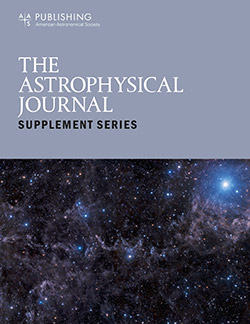中性和带电内、外面体金属富勒烯的红外光谱指纹图谱
IF 8.5
1区 物理与天体物理
Q1 ASTRONOMY & ASTROPHYSICS
引用次数: 0
摘要
含金属小分子是一种在空间中,特别是在演化恒星的星周包层中有效形成的杂合分子。也有人预测,在这些星周环境中可能存在更复杂的杂化物种,如由金属和富勒烯(金属富勒烯)形成的杂化物种。最近,金属富勒烯的量子化学模拟表明,它们是在不同类型的演化恒星的富富勒烯星周环境中观测到的中红外光谱的潜在发射体。在这里,我们给出了28种金属富勒烯的单个模拟中红外(~ 5-50 μ m)光谱。本文考虑了七种不同金属(Li, Na, K, Ca, Mg, Ti和Fe)的中性和带电的内、外面体金属富勒烯。利用电荷密度差图和电子密度分划,揭示了金属- c60相互作用引起的光谱特征的强度和位置变化。我们的计算确定了基本的红外光谱区域,根据金属结合的性质,每个金属富勒烯应该有一个主要的光谱贡献。金属富勒烯的红外光谱公开提供给天文学界,特别是詹姆斯·韦伯太空望远镜的用户,以进行比较,最终可能导致在太空中发现这些物种。本文章由计算机程序翻译,如有差异,请以英文原文为准。
Infrared Spectral Fingerprint of Neutral and Charged Endo- and Exohedral Metallofullerenes
Abstract Small metal-containing molecules have been detected and recognized as one of the hybrid species that are efficiently formed in space, especially in the circumstellar envelopes of evolved stars. It has also been predicted that more complex hybrid species such as those formed by metals and fullerenes (metallofullerenes) could be present in these circumstellar environments. Recently, quantum-chemical simulations of metallofullerenes have shown that they are potential emitters contributing to the observed mid-IR spectra in the fullerene-rich circumstellar environments of different types of evolved stars. Here we present the individual simulated mid-IR (∼5–50 μ m) spectra of 28 metallofullerene species. Both neutral and charged endo- and exohedral metallofullerenes for seven different metals (Li, Na, K, Ca, Mg, Ti, and Fe) have been considered. The changes induced by the metal–C 60 interaction in the intensity and position of the spectral features are highlighted using charge-density difference maps and electron-density partitioning. Our calculations identify the fundamental IR spectral regions in which, depending on the metal binding nature, there should be a major spectral contribution from each of the metallofullerenes. The IR spectra of the metallofullerenes are made publicly available to the astronomical community, especially users of the James Webb Space Telescope, for comparisons that could eventually lead to the detection of these species in space.
求助全文
通过发布文献求助,成功后即可免费获取论文全文。
去求助
来源期刊

Astrophysical Journal Supplement Series
地学天文-天文与天体物理
CiteScore
14.50
自引率
5.70%
发文量
264
审稿时长
2 months
期刊介绍:
The Astrophysical Journal Supplement (ApJS) serves as an open-access journal that publishes significant articles featuring extensive data or calculations in the field of astrophysics. It also facilitates Special Issues, presenting thematically related papers simultaneously in a single volume.
 求助内容:
求助内容: 应助结果提醒方式:
应助结果提醒方式:


